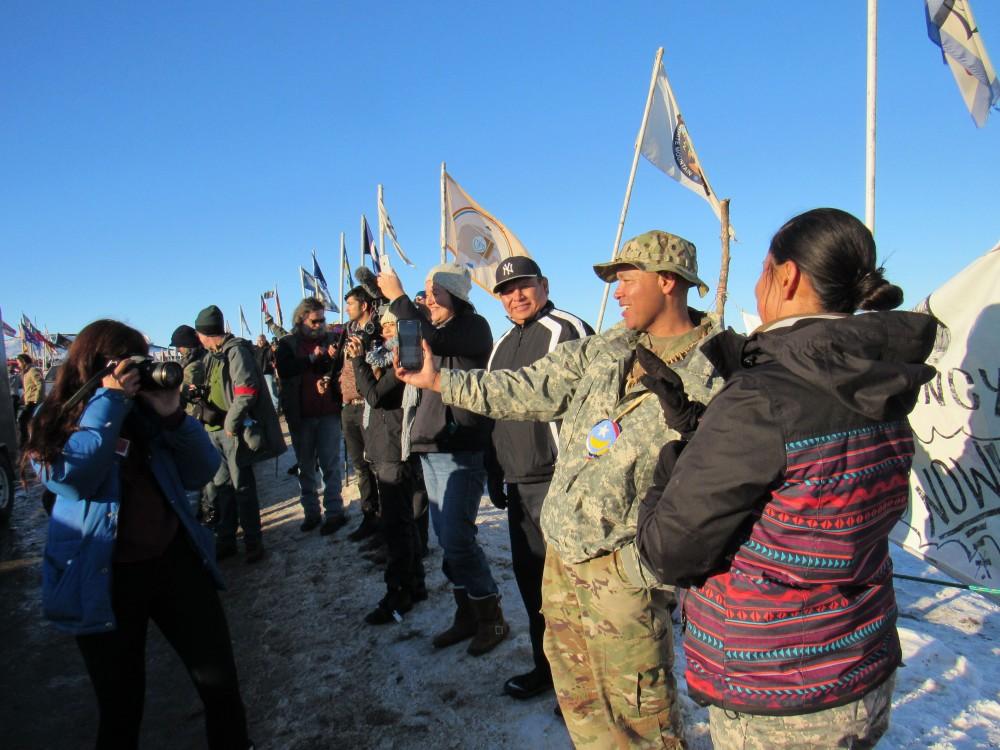Documenting resistance: Standing Rock photography installment highlights national movement, discussion

GVL / Courtesy – Levi Rickert
Feb 5, 2018
Starting in 2016, demonstrated resistance to the Dakota Access Pipeline running through the Standing Rock Sioux Reservation has been vibrant. Journalist Levi Rickert has captured the reactions of on-site confrontations and marches around the U.S. in more than 1,500 photographs, many of which are currently featured in the Mary Idema Pew Library’s newest Exhibition Space installment.
The exhibit, titled “Standing Rock: Photographs of an Indigenous Movement,” is a collection of Rickert’s work as an editor and publisher for Native News Online, which captured the protests as they unfolded. Filling the Exhibition Space with images of the movement and his accompanying narrative, Rickert aims to lay out the long story of the movement around the nation.
“The exhibition is laid out to tell the story of resistance, triumph and even survival at Standing Rock,” Rickert said via email. “The photographs help tell the story of American Indians’ long struggle to retain their indigenous sovereignty in contemporary times.”
The exhibition is a collaboration between Rickert and the Kutsche Office of Local History, directed by Kimberly McKee. As part of the Gi-gikinomaage-min Project—meaning “we are all teachers”—the exhibit aims to capture the lives and experiences of Native Americans in West Michigan, McKee said.
“In 2016 and 2017, our special projects graduate assistant worked closely with Mariano Avila from WGVU on the documentary ‘We the 7th,’ which documented the largest public gathering of American Indians in over 100 years at Standing Rock,” McKee said via email. “(It) followed the experiences of Native Americans from Michigan who felt compelled to lend their support at Standing Rock. … (This new) exhibit is part of our (continued) commitment to examine how a national movement has local connections.”
Working closely with Rickert, the office helped fund the exhibit, select photos, create graphics and manage the process, Rickert said. Through this collaboration, Rickert aimed to share a theme of rallying in his photography, especially supporting the importance of water to those in Standing Rock.
“In Lakota, the theme is ‘mni wiconi.’ In English, the saying is ‘water is life,’” Rickert said. “On the boards (in the exhibit) that contain the narrative and photos, water is screened into the background. The message of ‘water is life’ is woven in throughout the exhibition.”
For McKee, the exhibit is all about localizing a national issue. While issues of indigenous rights and environmental protection are key to the Standing Rock movement, representing those who resisted the pipeline locally is crucial to understanding how larger issues impact the community.
“(The Kutsche Office of Local History’s) mission is to give voice to diverse communities through history,” McKee said. “This exhibit preserves the experiences of Michiganders who traveled to Standing Rock and how the work nationally affects local efforts concerning environmental justice.”
While the stories and photographs stand on their own, Rickert said the turnout will ultimately determine the success of the exhibition. He said he aims to spread the message created by the Standing Rock movement to as many viewers as possible in order to educate them on the importance of water to life.
“I think the success will be when (interested) institutions and others sign up to host the exhibition so that more people beyond GVSU will view it—with the hope that others will become educated about why water protection is critical to survival of humans regardless of skin color,” Rickert said.
Rickert believes that discussions created by this exhibit are as important as ever due to the distance in time from the climax of the movement. This distance gives protesters and bystanders alike time to reflect, lending this installment greater depth, Rickert said. He hopes this allows viewers to see that the movement pertains to all Americans, not just those on the reservation.
“In a broader sense, Standing Rock was about the environment,” Rickert said. “It was about big oil companies doing what they want to do for their own benefit. So, even though Standing Rock was an indigenous movement, the environment should be a concern of all responsible Americans.”






















